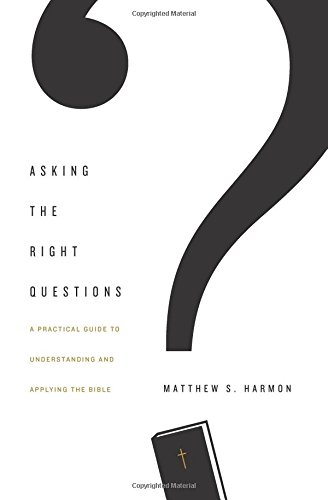A Brief Book Summary from Books At a Glance
by Benjamin Montoya
About the Author
Matthew S. Harmon (Ph.D., Wheaton College) is professor of New Testament studies at Grace College and Theological Seminary in Winona Lake, Indiana. He was previously on staff with Cru for eight years and is the author of several books. Matthew and his wife, Kate, live in Warsaw, Indiana, and have two sons.
Introduction
We often leave people hanging when it comes to learning how to read the Bible. That is, after someone becomes a Christian, we tell them to read their Bible. But, tell me something, did anyone ever take time to show you how to read it? Could this very issue be at the heart of other problems? For example, we have probably all attended a small group Bible study in which the Bible was not studied at all. Might the underlying problem be a lack of discipleship in how to study the Bible? Matthew S. Harmon has written this book to help us learn how to read the Bible by asking the right question.
In This Book, You Will Learn:
- That reading the Bible well is a matter of asking the right questions
- The right questions to ask about a variety of a number of issues
- The larger story of the Bible
- How to read our lives
- How to read God’s Word on a regular basis
- How to obey God’s Word
The Larger Contribution of This Book:
Books on how to read the Bible are more common than politicians in the news. They crop up regularly. Good books on how to read the Bible, however, are uncommon. This book is probably one of the best popular treatments of how to read the Bible. In addition to getting at the meaning of the text and how to apply it, this book reminds us of the importance of understanding the larger story of the Bible while seeking to apply it. Furthermore, this book helps us understand ourselves, our fallen condition, and how to apply God’s Word to it by using the gospel solution. Thus, the book focuses on applying the gospel as both the entry point of the Christian life and the pattern for our entire lives.
Table of Contents
Introduction
Part 1 Laying the Foundation
Chapter 1 The Story We Find Ourselves In
Chapter 2 The Bible Is God’s Tool to Change Us
Part 2 Reading the Bible
Chapter 3 Reading the Bible as Jesus Did
Chapter 4 Written for Us but Not to Us
Chapter 5 Four Foundational Questions
Part 3 Reading Our Lives
Chapter 6 The Gospel Pattern of Life
Chapter 7 The Fallen Condition
Chapter 8 The Gospel Solution
Chapter 9 Applying the Bible to Our Whole Lives
Chapter 10 The Power to Obey
Conclusion
Summary
Part 1: Laying the Foundation
Chapter 1: The Story We Find Ourselves In
The Bible presents us with one larger story. The purpose of this story is not to entertain us or merely provide us with information. Rather, this story is intended to point us to the God of the Bible and explain reality to us. Because of our sin, we are tempted to tell ourselves false stories about how the world works. The Bible begins with creation. God made everything good to bring glory to himself. He made us in His image. He also created us to live in community; instead of leaving Adam alone, God give Adam Eve. This relationship helps man understand what community is all about. But, the story of the Bible takes a tragic twist.
The second major part of the story of the Bible is the crisis of the Fall. Adam and Eve sinned against God in their desire to become like God. Satan came in the form of a serpent, tempted Adam and Eve, and they fell. As a result, all humans now experience shame and guilt about our evil deeds. God, however, does not give up on His creation. Although Adam and Eve died in their sin that day, God was not finished with them or the rest of humanity. Rather, He made a promise in Genesis 3:15 that He would send the serpent-crusher.
The third part of the story of the Bible includes the covenants that God made with man. “A covenant is a solemn commitment that God makes with a specific person or group of people to do and/or be something. As part of that commitment, God makes promises and places himself under an oath to fulfill them.” God made covenants with Noah, Abraham, his descendants, Israel, and his children. All the covenants God made, however, point back to the promise He made to Adam and Eve to send the snake-crusher. Nevertheless, God’s people were unfaithful to the covenants God made with them. Repeatedly they disobeyed because of their sinful hearts. God, however, promised that He would make a new covenant in which He would change them to become an obedient people. The OT points in this direction, by its end, there is no fulfillment of the promises God made. . . .
[To continue reading this summary, please see below....]The remainder of this article is premium content. Become a member to continue reading.
Already have an account? Sign In
